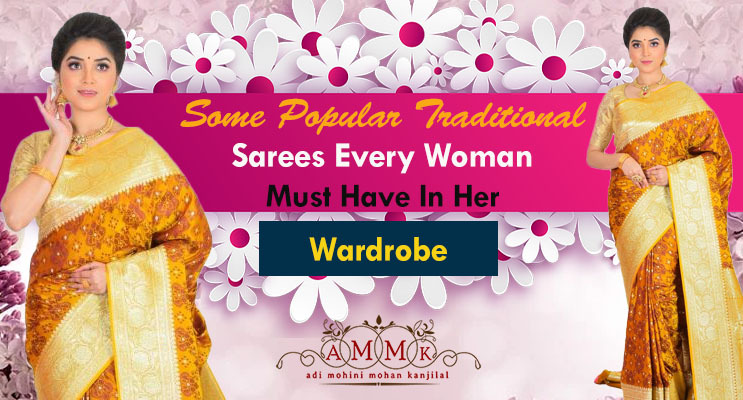
Some Popular Traditional Sarees Every Woman Must Have in Her Wardrobe
We Indians wear our tradition on our sleeves and breathe in the air of celebrations. From wedding to baby shower, from Durga Puja to Makar Sankranti, from Holi to Diwali, we love to celebrate our age-old traditions with lights, colors, rituals as well as through our attires. In India, celebrations are synonymous with its traditional sarees. From different kinds of silks, to traditional weaving techniques, thread works, patterns, designs, and draping styles, the canvas of traditional sarees is full of granger, vibrance, and variety. Therefore, this blog will throw lights on some popular traditional sarees that every women must in her wardrobe. Stay hooked.
Benarasi Saree
The one that tops the chart is a traditional Benarasi saree. Emerging from the holy lands of Varanasi, a Benarasi saree speaks of our Indian cultures and customs. Authentic silk fabric, flawless weaving, pure gold or silver Zari works, elaborate thread works, and traditional designs, Benarasi saree truly represents the richness of art that this land has practiced since time immemorial. A bride’s ultimate choice, this elegant saree also makes room for contemporary and fusion styling.
Chanderi Silk Saree
Chanderi silk is one of the most popular traditional sarees that Indian women hold close to their hearts. A very famous handloom corner in the city of Madhya Pradesh, named Chanderi has given birth to this beautiful and elegant traditional fabric. Chanderi sarees are unique for its shimmery look and sheer. An authentic Chanderi silk saree follows the age old weaving techniques that blends silk and Zari threads on cotton yarns, thus giving a shimmery bi-color appearance. This traditional drape is again perfect for wedding.
Kanchipuram Saree
A traditional take on the authentic mulberry silk is the predominant feature of a Kanchipuram silk saree. Emerging from the Southern territories of India, this traditional saree has its home in the Kanchipuram province in Tamil Nadu. The Zari is made of pure gold and silver and they arrive from Gujarat. The process of making Kanchipuram sarees involve silk threads dipping in thick rice water followed by multiple rounds of sun dry methods. Thus, these sarees are thick and hard. The colors are bright and contrasting with traditional South Indian designs.
Tussar Saree
Tussar, a traditional fabric that associates with the festive celebrations of Eastern India, is a rich heritage saree material. Emerging in the lands of Durga puja, West Bengal, these sarees are made of authentic silk worms that breed in the forest regions. However, the silk threads are shorter in size. Therefore, the sarees tend to tear apart easily. Tussar silk sarees have a sublime hint of golden yellow along with a rough texture. In Bengali culture and customs, these sarees are highly chosen for traditional fashion during the festive seasons.
Chikankari Saree
One of the most beautiful traditional drape comes in the form of Chikankari saree. Evolved in the ancient land of Nawabs, Lucknow, this Indian saree uses cotton yarns predominantly. Apart from its signature thread works, intricate designs, graceful colors, and elaborate pallu works, Chikankari saree has a great reflection of the Nabawi gharana and Mughal inspirations in its motifs and patterns. An epitome of grace and elegance, Chikankari sarees allow the beautiful blend of traditions, trends, and sophistication.
